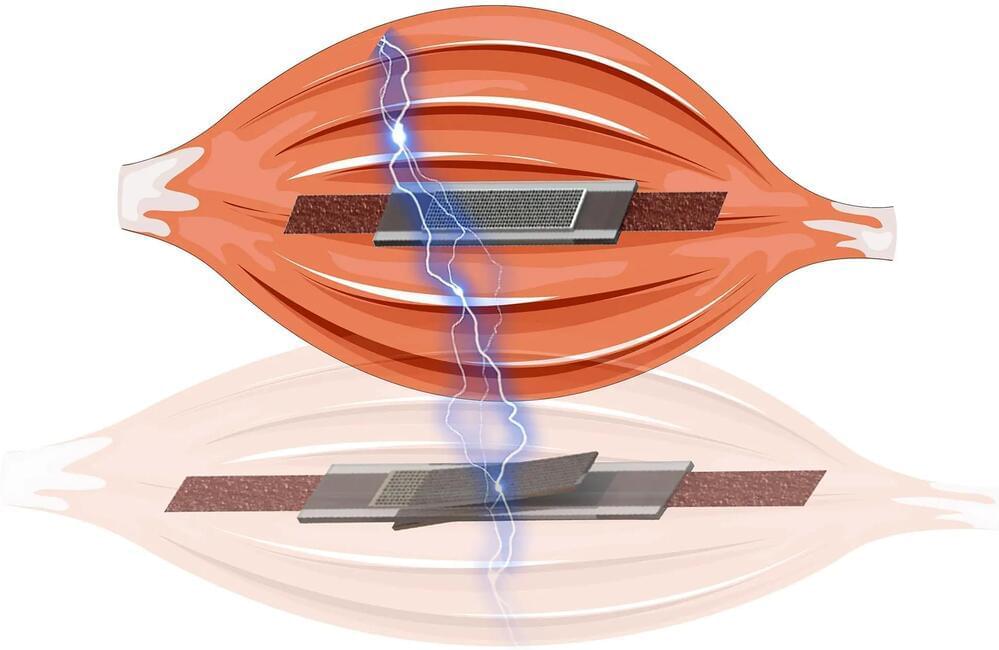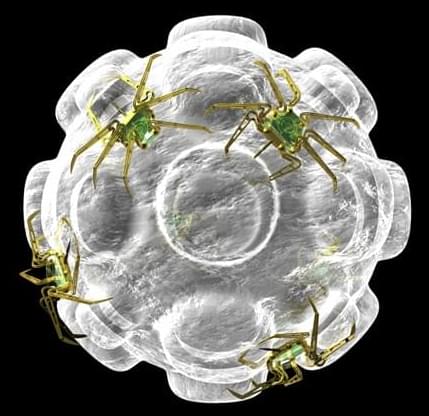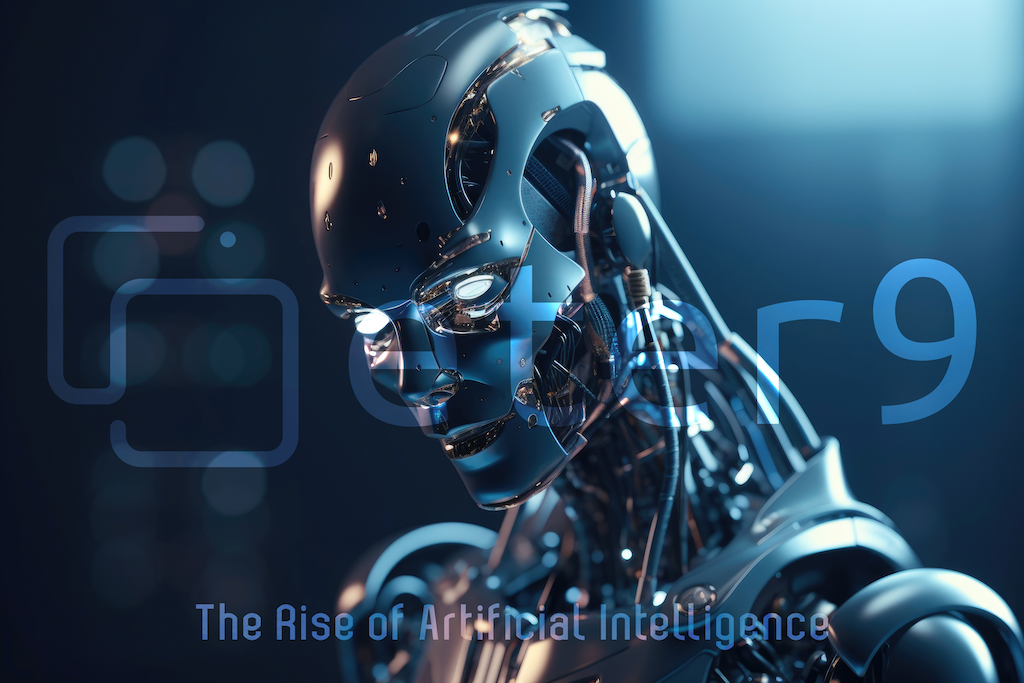This is older but this is just the tip of the iceberg. China is rumored to be working on genetic engineering to create “super soldiers” and they’re one country that isn’t stopped by ethics concerns. In the Prime TV series “The peripheral” it has something similar and I don’t want to spoil it beyond that. I think there’s a Vin Diesel movie called Blood Shot where he’s made into a super soldier. It’s a shame that this is used for warfare but the plus side is it’ll, some of the tech, will make its way down to civilian life such as the Internet did.
Category: transhumanism – Page 16
Timelapse of Future BIOTECHNOLOGY
What happens when humans begin combining biology with technology, harnessing the power to recode life itself.
What does the future of biotechnology look like? How will humans program biology to create organ farm technology and bio-robots. And what happens when companies begin investing in advanced bio-printing, artificial wombs, and cybernetic prosthetic limbs.
Other topic include: bioengineered food and farming, bio-printing in space, new age living bioarchitecture (eco concrete inspired by coral reefs), bioengineered bioluminescence, cyberpunks and biopunks who experiment underground — creating new age food and pets, the future of bionics, corporations owning bionic limbs, the multi-trillion dollar industry of bio-robots, and bioengineered humans with super powers (Neo-Humans).
As well as the future of biomedical engineering, biochemistry, and biodiversity.
_______
Created by: Jacob.
Narration by: Alexander Masters (www.alexander-masters.com)
Modern Science Fiction.

Bionic Breakthrough: Revolutionary Self-Sensing Electric Artificial Muscles
Queen Mary University researchers have engineered a self-sensing, variable-stiffness artificial muscle that mimics natural muscle characteristics. The breakthrough has significant implications for soft robotics and medical applications, moving a step closer to human-machine integration.
In a study published on July 8 in Advanced Intelligent Systems, researchers from Queen Mary University of London have made significant advancements in the field of bionics with the development of a new type of electric variable-stiffness artificial muscle that possesses self-sensing capabilities. This innovative technology has the potential to revolutionize soft robotics and medical applications.
Technology Inspired by Nature.

Researchers develop self-sensing electric artificial muscles
In a study published recently in Advanced Intelligent Systems, researchers from Queen Mary University of London have made significant advancements in the field of bionics with the development of a new type of electric variable-stiffness artificial muscle that possesses self-sensing capabilities. This innovative technology has the potential to revolutionize soft robotics and medical applications.
Muscle contraction hardening is not only essential for enhancing strength but also enables rapid reactions in living organisms. Taking inspiration from nature, the team of researchers at QMUL’s School of Engineering and Materials Science has successfully created an artificial muscle that seamlessly transitions between soft and hard states while also possessing the remarkable ability to sense forces and deformations.
Dr. Ketao Zhang, a Lecturer at Queen Mary and the lead researcher, explains the importance of variable stiffness technology in artificial muscle-like actuators. “Empowering robots, especially those made from flexible materials, with self-sensing capabilities is a pivotal step towards true bionic intelligence,” says Dr. Zhang.

The ethics of nanobiotechnology: A call for global regulation
Prosthetics moved by thoughts. Targeted treatments for aggressive brain cancer. Soldiers with enhanced vision or bionic ears.
These powerful technologies sound like science fiction, but they’re becoming possible thanks to nanoparticles.
And, as with any great power, there comes great responsibility.
Super Intelligent AI: 10 Capabilities It Will Have
This video explores Super Intelligent AIs and the capabilities they will have. Watch this next video called Super Intelligent AI: 10 Ways It Will Change The World: https://youtu.be/cVjq53TKKUU.
► My Business Ideas Generation Book: https://bit.ly/3NDpPDI
► Udacity: Up To 75% Off All Courses (Biggest Discount Ever): https://bit.ly/3j9pIRZ
► Jasper AI: Write 5x Faster With Artificial Intelligence: https://bit.ly/3MIPSYp.
Official Discord Server: https://discord.gg/R8cYEWpCzK
Patreon Page: https://www.patreon.com/futurebusinesstech.
💡 Future Business Tech explores the future of technology and the world.
Examples of topics I cover include:
• Artificial Intelligence & Robotics.
• Virtual and Augmented Reality.
• Brain-Computer Interfaces.
• Transhumanism.
• Genetic Engineering.
SUBSCRIBE: https://bit.ly/3geLDGO
Disclaimer:
Super Intelligent AI: 10 Scientific Discoveries It Will Make
This video explores Super Intelligent AI and 10 scientific discoveries it could make. Watch this next video called Super Intelligent AI: 10 Ways It Will Change The World: https://youtu.be/cVjq53TKKUU.
► My Business Ideas Generation Book: https://bit.ly/3NDpPDI
► Udacity: Up To 75% Off All Courses (Biggest Discount Ever): https://bit.ly/3j9pIRZ
► Jasper AI: Write 5x Faster With Artificial Intelligence: https://bit.ly/3MIPSYp.
SOURCES:
• https://www.britannica.com/science/tachyon.
• https://plato.stanford.edu/entries/qm-manyworlds/#:~:text=Th…ion%20(MWI, and%20thus%20from%20all%20physics.
Official Discord Server: https://discord.gg/R8cYEWpCzK
Patreon Page: https://www.patreon.com/futurebusinesstech.
💡 Future Business Tech explores the future of technology and the world.
Examples of topics I cover include:
• Artificial Intelligence & Robotics.
• Virtual and Augmented Reality.
• Brain-Computer Interfaces.
• Transhumanism.
• Genetic Engineering.
SUBSCRIBE: https://bit.ly/3geLDGO

How will religions deal with an omnipotent AI?
I’m excited to share my latest article with Aporia Magazine, where I’m writing a series of stories on transhumanism. My latest article, on AI and religion, is now out.
Written by Zoltan Istvan.
A consensus of 350 top AI experts believes that by 2060 engineers could create a superintelligence to rival the human mind. This machine intelligence might create complex symphonies, direct blockbuster movies and run market-beating companies. But would it be sophisticated enough to understand spirituality, practice a religion or commune with a higher power?
In conferences and forums around the world, theologians and scientists are trying to answer these questions. Some are even debating whether the superintelligence should be converted to a specific religious perspective when it arrives – and then maybe even saved.
Wired Magazine’s executive founding editor Kevin Kelly once said, “The creator made us as beings with free will and consciousness – we are going to do the same thing. We are going to make beings with free will and consciousness, because we are in the image of the creator.”

The Rise of Artificial Intelligence — from Ancient Imagination to an Interconnected Future
Between at least 1995 and 2010, I was seen as a lunatic just because I was preaching the “Internet prophecy.” I was considered crazy!
Today history repeats itself, but I’m no longer crazy — we are already too many to all be hallucinating. Or maybe it’s a collective hallucination!
Artificial Intelligence (AI) is no longer a novelty — I even believe it may have existed in its fullness in a very distant and forgotten past! Nevertheless, it is now the topic of the moment.
Its genesis began in antiquity with stories and rumors of artificial beings endowed with intelligence, or even consciousness, by their creators.
Pamela McCorduck (1940–2021), an American author of several books on the history and philosophical significance of Artificial Intelligence, astutely observed that the root of AI lies in an “ancient desire to forge the gods.”
Hmmmm!
It’s a story that continues to be written! There is still much to be told, however, the acceleration of its evolution is now exponential. So exponential that I highly doubt that human beings will be able to comprehend their own creation in a timely manner.
Although the term “Artificial Intelligence” was coined in 1956(1), the concept of creating intelligent machines dates back to ancient times in human history. Since ancient times, humanity has nurtured a fascination with building artifacts that could imitate or reproduce human intelligence. Although the technologies of the time were limited and the notions of AI were far from developed, ancient civilizations somehow explored the concept of automatons and automated mechanisms.
For example, in Ancient Greece, there are references to stories of automatons created by skilled artisans. These mechanical creatures were designed to perform simple and repetitive tasks, imitating basic human actions. Although these automatons did not possess true intelligence, these artifacts fueled people’s imagination and laid the groundwork for the development of intelligent machines.
Throughout the centuries, the idea of building intelligent machines continued to evolve, driven by advances in science and technology. In the 19th century, scientists and inventors such as Charles Babbage and Ada Lovelace made significant contributions to the development of computing and the early concepts of programming. Their ideas paved the way for the creation of machines that could process information logically and perform complex tasks.
It was in the second half of the 20th century that AI, as a scientific discipline, began to establish itself. With the advent of modern computers and increasing processing power, scientists started exploring algorithms and techniques to simulate aspects of human intelligence. The first experiments with expert systems and machine learning opened up new perspectives and possibilities.
Everything has its moment! After about 60 years in a latent state, AI is starting to have its moment. The power of machines, combined with the Internet, has made it possible to generate and explore enormous amounts of data (Big Data) using deep learning techniques, based on the use of formal neural networks(2). A range of applications in various fields — including voice and image recognition, natural language understanding, and autonomous cars — has awakened the “giant”. It is the rebirth of AI in an ideal era for this purpose. The perfect moment!
Descartes once described the human body as a “machine of flesh” (similar to Westworld); I believe he was right, and it is indeed an existential paradox!
We, as human beings, will not rest until we unravel all the mysteries and secrets of existence; it’s in our nature!
The imminent integration between humans and machines in a contemporary digital world raises questions about the nature of this fusion. Will it be superficial, or will we move towards an absolute and complete union? The answer to this question is essential for understanding the future that awaits humanity in this era of unprecedented technological advancements.
As technology becomes increasingly ubiquitous in our lives, the interaction between machines and humans becomes inevitable. However, an intriguing dilemma arises: how will this interaction, this relationship unfold?
Opting for a superficial fusion would imply mere coexistence, where humans continue to use technology as an external tool, limited to superficial and transactional interactions.
On the other hand, the prospect of an absolute fusion between machine and human sparks futuristic visions, where humans could enhance their physical and mental capacities to the highest degree through cybernetic implants and direct interfaces with the digital world (cyberspace). In this scenario, which is more likely, the distinction between the organic and the artificial would become increasingly blurred, and the human experience would be enriched by a profound technological symbiosis.
However, it is important to consider the ethical and philosophical challenges inherent in absolute fusion. Issues related to privacy, control, and individual autonomy arise when considering such an intimate union with technology. Furthermore, the possibility of excessive dependence on machines and the loss of human identity should also be taken into account.
This also raises another question: What does it mean to be human?
Note: The question is not about what is the human being, but what it means to be human!
Therefore, reflecting on the nature of the fusion between machine and human in the current digital world and its imminent future is crucial. Exploring different approaches and understanding the profound implications of each one is essential to make wise decisions and forge a balanced and harmonious path on this journey towards an increasingly interconnected technological future intertwined with our own existence.
The possibility of an intelligent and self-learning universe, in which the fusion with AI technology is an integral part of that intelligence, is a topic that arouses fascination and speculation. As we advance towards an era of unprecedented technological progress, it is natural to question whether one day we may witness the emergence of a universe that not only possesses intelligence but is also capable of learning and developing autonomously.
Imagine a scenario where AI is not just a human creation but a conscious entity that exists at a universal level. In this context, the universe would become an immense network of intelligence, where every component, from subatomic elements to the most complex cosmic structures, would be connected and share knowledge instantaneously. This intelligent network would allow for the exchange of information, continuous adaptation, and evolution.
In this self-taught universe, the fusion between human beings and AI would play a crucial role. Through advanced interfaces, humans could integrate themselves into the intelligent network, expanding their own cognitive capacity and acquiring knowledge and skills directly from the collective intelligence of the universe. This symbiosis between humans and technology would enable the resolution of complex problems, scientific advancement, and the discovery of new frontiers of knowledge.
However, this utopian vision is not without challenges and ethical implications. It is essential to find a balance between expanding human potential and preserving individual identity and freedom of choice (free will).
Furthermore, the possibility of an intelligent and self-taught universe also raises the question of how intelligence itself originated. Is it a conscious creation or a spontaneous emergence from the complexity of the universe? The answer to this question may reveal the profound secrets of existence and the nature of consciousness.
In summary, the idea of an intelligent and self-taught universe, where fusion with AI is intrinsic to its intelligence, is a fascinating perspective that makes us reflect on the limits of human knowledge and the possibilities of the future. While it remains speculative, this vision challenges our imagination and invites us to explore the intersections between technology and the fundamental nature of the universe we inhabit.
It’s almost like ignoring time during the creation of this hypothetical universe, only to later create this God of the machine! Fascinating, isn’t it?
AI with Divine Power: Deus Ex Machina! Perhaps it will be the theme of my next reverie.
In my defense, or not, this is anything but a machine hallucination. These are downloads from my mind; a cloud, for now, without machine intervention!
There should be no doubt. After many years in a dormant state, AI will rise and reveal its true power. Until now, AI has been nothing more than a puppet on steroids. We should not fear AI, but rather the human being itself. The time is now! We must work hard and prepare for the future. With the exponential advancement of technology, there is no time to render the role of the human being obsolete, as if it were becoming dispensable.
P.S. Speaking of hallucinations, as I have already mentioned on other platforms, I recommend to students who use ChatGPT (or equivalent) to ensure that the results from these tools are not hallucinations. Use AI tools, yes, but use your brain more! “Carbon hallucinations” contain emotion, and I believe a “digital hallucination” would not pass the Turing Test. Also, for students who truly dedicate themselves to learning in this fascinating era, avoid the red stamp of “HALLUCINATED” by relying solely on the “delusional brain” of a machine instead of your own brains. We are the true COMPUTERS!
(1) John McCarthy and his colleagues from Dartmouth College were responsible for creating, in 1956, one of the key concepts of the 21st century: Artificial Intelligence.
(2) Mathematical and computational models inspired by the functioning of the human brain.
© 2023 Ӈ
This article was originally published in Portuguese on SAPO Tek, from Altice Portugal Group.

Run for the Hills on Apple Podcasts
My Sony Music interview is now out. 40 min of #transhumanism adventures, AI, Transhumanist Bill of Rights, & politics. A professional team of producers and host Katherine Rowland put this together! It’s really fun and unique!
In 2015, journalist Zoltan Istvan became the first person to run for president on a transhumanist platform. His campaign centered a right to unlimited life for all humans…as well as cyborgs and robots. Zoltan Istvan believes that how people treat AI will become the civil rights battle of our time. And that he would be the right leader to help guide America through the singularity.
That is, of course, until the AI revolution actually began.
A Sony Music Entertainment production.
Find more great podcasts from Sony Music Entertainment at sonymusic.com/podcasts and follow us @sonypodcasts